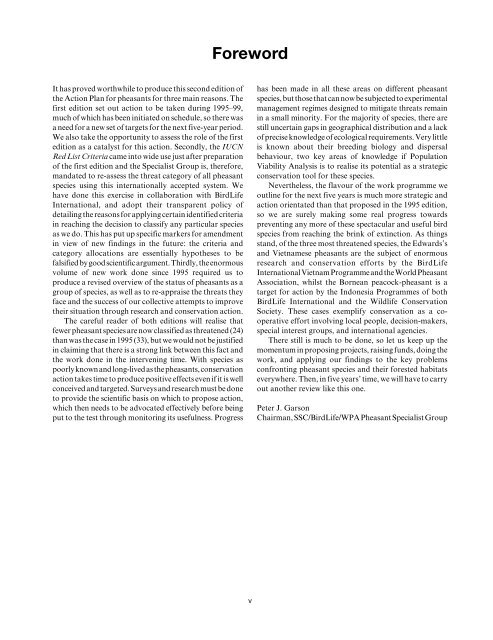Pheasants: Status Survey and Conservation Action Plan ... - IUCN
Pheasants: Status Survey and Conservation Action Plan ... - IUCN
Pheasants: Status Survey and Conservation Action Plan ... - IUCN
You also want an ePaper? Increase the reach of your titles
YUMPU automatically turns print PDFs into web optimized ePapers that Google loves.
Foreword<br />
It has proved worthwhile to produce this second edition of<br />
the <strong>Action</strong> <strong>Plan</strong> for pheasants for three main reasons. The<br />
first edition set out action to be taken during 1995–99,<br />
much of which has been initiated on schedule, so there was<br />
a need for a new set of targets for the next five-year period.<br />
We also take the opportunity to assess the role of the first<br />
edition as a catalyst for this action. Secondly, the <strong>IUCN</strong><br />
Red List Criteria came into wide use just after preparation<br />
of the first edition <strong>and</strong> the Specialist Group is, therefore,<br />
m<strong>and</strong>ated to re-assess the threat category of all pheasant<br />
species using this internationally accepted system. We<br />
have done this exercise in collaboration with BirdLife<br />
International, <strong>and</strong> adopt their transparent policy of<br />
detailing the reasons for applying certain identified criteria<br />
in reaching the decision to classify any particular species<br />
as we do. This has put up specific markers for amendment<br />
in view of new findings in the future: the criteria <strong>and</strong><br />
category allocations are essentially hypotheses to be<br />
falsified by good scientific argument. Thirdly, the enormous<br />
volume of new work done since 1995 required us to<br />
produce a revised overview of the status of pheasants as a<br />
group of species, as well as to re-appraise the threats they<br />
face <strong>and</strong> the success of our collective attempts to improve<br />
their situation through research <strong>and</strong> conservation action.<br />
The careful reader of both editions will realise that<br />
fewer pheasant species are now classified as threatened (24)<br />
than was the case in 1995 (33), but we would not be justified<br />
in claiming that there is a strong link between this fact <strong>and</strong><br />
the work done in the intervening time. With species as<br />
poorly known <strong>and</strong> long-lived as the pheasants, conservation<br />
action takes time to produce positive effects even if it is well<br />
conceived <strong>and</strong> targeted. <strong>Survey</strong>s <strong>and</strong> research must be done<br />
to provide the scientific basis on which to propose action,<br />
which then needs to be advocated effectively before being<br />
put to the test through monitoring its usefulness. Progress<br />
has been made in all these areas on different pheasant<br />
species, but those that can now be subjected to experimental<br />
management regimes designed to mitigate threats remain<br />
in a small minority. For the majority of species, there are<br />
still uncertain gaps in geographical distribution <strong>and</strong> a lack<br />
of precise knowledge of ecological requirements. Very little<br />
is known about their breeding biology <strong>and</strong> dispersal<br />
behaviour, two key areas of knowledge if Population<br />
Viability Analysis is to realise its potential as a strategic<br />
conservation tool for these species.<br />
Nevertheless, the flavour of the work programme we<br />
outline for the next five years is much more strategic <strong>and</strong><br />
action orientated than that proposed in the 1995 edition,<br />
so we are surely making some real progress towards<br />
preventing any more of these spectacular <strong>and</strong> useful bird<br />
species from reaching the brink of extinction. As things<br />
st<strong>and</strong>, of the three most threatened species, the Edwards’s<br />
<strong>and</strong> Vietnamese pheasants are the subject of enormous<br />
research <strong>and</strong> conservation efforts by the BirdLife<br />
International Vietnam Programme <strong>and</strong> the World Pheasant<br />
Association, whilst the Bornean peacock-pheasant is a<br />
target for action by the Indonesia Programmes of both<br />
BirdLife International <strong>and</strong> the Wildlife <strong>Conservation</strong><br />
Society. These cases exemplify conservation as a cooperative<br />
effort involving local people, decision-makers,<br />
special interest groups, <strong>and</strong> international agencies.<br />
There still is much to be done, so let us keep up the<br />
momentum in proposing projects, raising funds, doing the<br />
work, <strong>and</strong> applying our findings to the key problems<br />
confronting pheasant species <strong>and</strong> their forested habitats<br />
everywhere. Then, in five years’ time, we will have to carry<br />
out another review like this one.<br />
Peter J. Garson<br />
Chairman, SSC/BirdLife/WPA Pheasant Specialist Group<br />
v
















